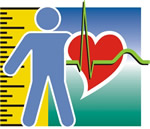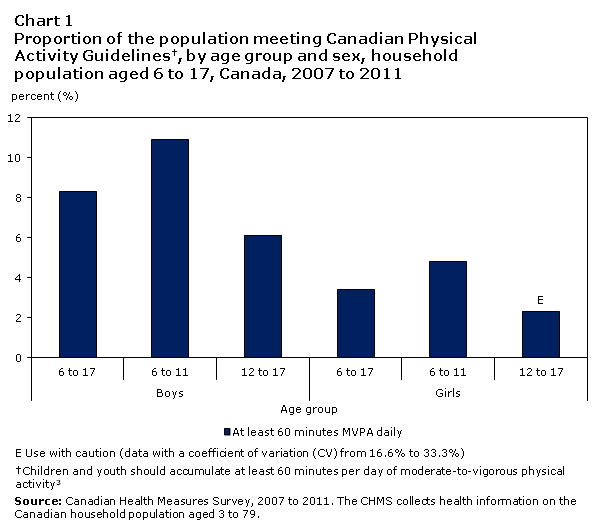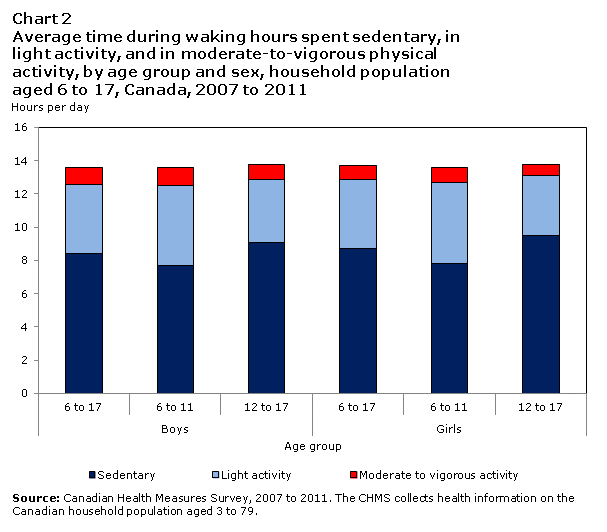Publications
Directly measured physical activity of Canadian children and youth, 2007 to 2011
Directly measured physical activity of Canadian children and youth, 2007 to 2011
Archived Content
Information identified as archived is provided for reference, research or recordkeeping purposes. It is not subject to the Government of Canada Web Standards and has not been altered or updated since it was archived. Please "contact us" to request a format other than those available.
Regular physical activity and limited sedentary time contribute to many health benefits for children and youth, such as improved cholesterol levels, blood pressure, muscle and bone health, cardiorespiratory fitness, academic achievement, and improved mental health.1,2
About physical activity
 Moderate-to-vigorous physical activity (MVPA) is activity which causes a person to sweat and breathe harder or be out of breath (e.g.; skating, bike riding, playground activities, running, rollerblading, swimming).
Moderate-to-vigorous physical activity (MVPA) is activity which causes a person to sweat and breathe harder or be out of breath (e.g.; skating, bike riding, playground activities, running, rollerblading, swimming).
Light physical activity includes activities such as light play and leisurely walking.
Inactive or sedentary time includes any time spent sitting or lying down (e.g.; watching television, playing computer or video games, car travel).
The Canadian Physical Activity Guidelines recommend that children and youth aged 6 to 17 get at least 60 minutes of MVPA per day.3 The Canadian Sedentary Behaviour Guidelines recommend that children and youth should also minimize the amount of time they spend being sedentary each day.3
Few Canadian children and youth met the physical activity guidelines
About 8% of boys and 4% of girls aged 6 to 17 met the current guidelines for MVPA (Chart 1). Younger children were more likely to have met the guidelines for MVPA than older children and youth for both boys and girls. Boys aged 6 to 11 were the most active (11% met the guidelines), while girls aged 12 to 17 were the least active (2% met the guidelines).

Children and youth were sedentary during the majority of their waking hours
Children and youth aged 6 to 17 spend an average of 9 hours, or 64% of their waking hours, being sedentary each day (data not shown). Time spent sedentary is higher in youth aged 12 to 17 (9 hours for males and 10 hours for females) compared to children 6 to 11 years of age (8 hours for both boys and girls) (Chart 2).

Overweight and obese boys were less likely to be active
Overweight and obese4 boys were not as active as normal-weight4 boys. Nearly 10% of normal weight boys met the guidelines of 60 minutes of MVPA daily. This compares with 6% of overweight and 5% of obese boys who were active (data not shown). No difference was found in activity levels between overweight, obese or normal-weight girls.
Data source
Data are from the 2007 to 2011 Canadian Health Measures Survey (CHMS; cycles 1 and 2 combined). The CHMS collected data from a nationally representative sample of Canadians aged 6 to 79 years from collection sites across Canada. Basic demographic and health information was collected during a household interview, followed by a series of direct physical measurements taken at a mobile examination centre (MEC). Respondents at the MEC were provided with an activity monitor to wear for the week following their appointment. Activity monitors measure the amount of movement a person makes in order to determine the time spent in sedentary, light, and MVPA.
Provincial, census metropolitan area (CMA) or health region information on self-reported physical activity can be found in CANSIM table 105-0501 from the Canadian Community Health Survey (CCHS).
References
- Janssen I, Leblanc A. 2010. ‘A systematic review of the health benefits of physical activity and fitness in school-aged children and youth’. International Journal of Behavioral Nutrition and Physical Activity, vol. 7, no. 40.
- Tremblay MS, Allana AG, Janssen I, Kho ME, Hicks A, Murumets K, Colley RC, Duggan M. 2011. ‘Canadian Sedentary Behaviour Guidelines for Children and Youth’. Applied Physiology, Nutrition, and Metabolism, vol. 36:59-64.
- Canadian Society for Exercise Physiology. 2011. Canadian Physical Activity Guidelines. Ottawa, ON. www.csep.ca/guidelines. Accessed March 1, 2012.
- Statistics Canada. Body mass index of Canadian children and youth, 2009 to 2011. Health Fact Sheet. 82-625-X. http://www.statcan.gc.ca/pub/82-625-x/2012001/article/11712-eng.htm
- Date modified:
